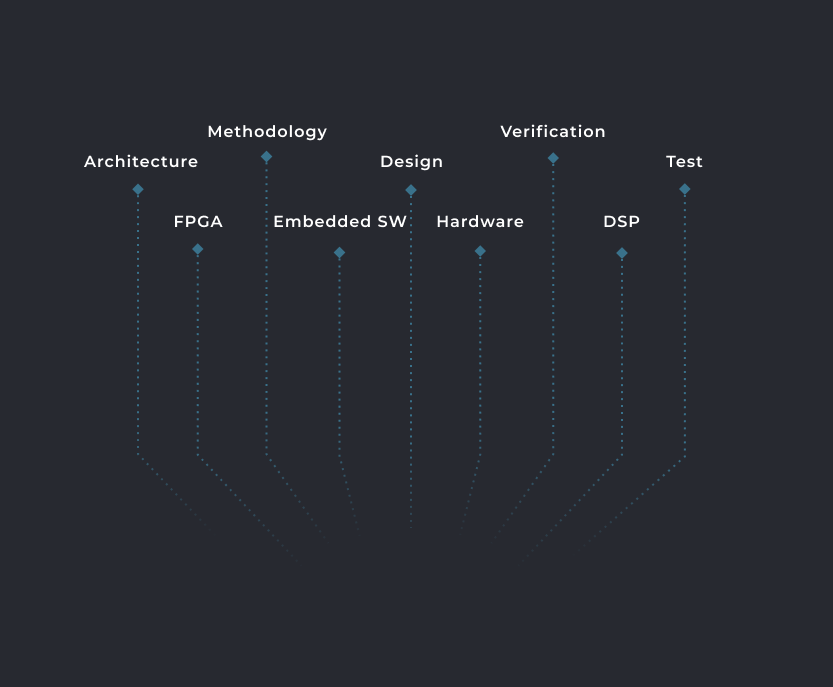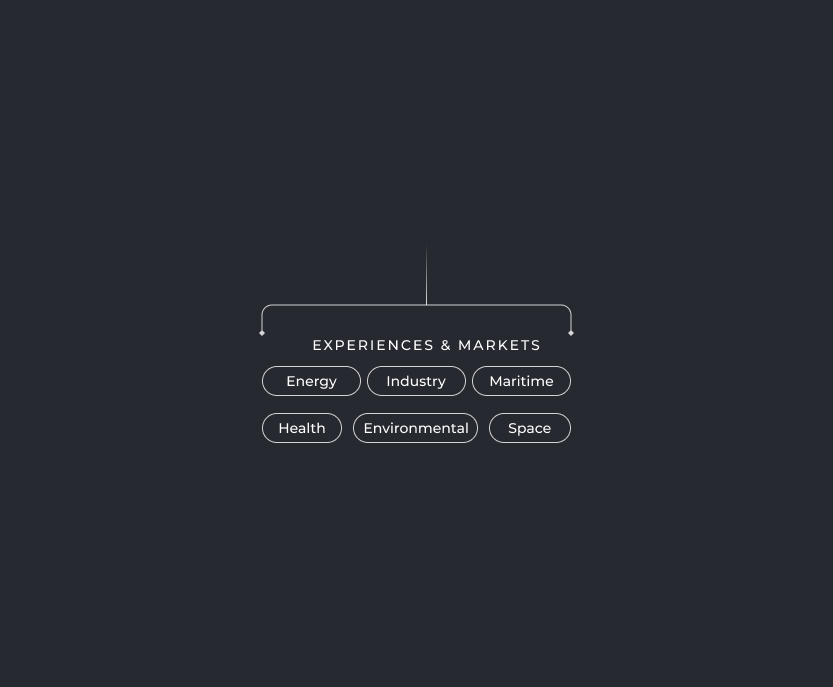Specialists on Embedded Systems




Some of our customers


Experiences & Markets
EmLogic’s engineers have extensive experience from various industries. We have helped our customers with building solid architecture, simplified processes and removed unnecessary complexity. We have provided code that orbits the earth, and FPGAs that work at the depths of the ocean. We have built drivers for autonomous drones, designed PCB layout for ultrasound devices, written code for induction heating solutions, and we have helped a customer make the tablets of the future!
- Space
- Maritime
- Health
- Environmental
- Energy
- Industry
- Others
Space
The space industry is a crucial domain for us at EmLogic, and within this area we have extensive experience.
We design with the quality that is needed and the requirements that exist for space, and follow ESA’s process. We have created functionality in UVVM to facilitate the design process for ESA projects.
EmLogic have helped several customers with various tasks.
Take a little slider tour to see some of the projects we have been working on!
NASA - Rimfax radar on Mars 2020 Rover
The 18th of February 2021 is an important date in the human space history. On this day NASA´s Rover Perseverance landed on Mars! You can watch the landing here.
On this project our engineers helped out with digital signal processing and FPGA (space graded) design and verification on dual technologies, on the Rimfax Radar. This radar is going to see geologic features under the surface with ground-penetrating radar.
S&T - ESA In Orbit Demonstrator
We helped S[&]T developing a part of a Norwegian Smallsat Ecosystem. This system enables object detection from satellite images, where everything is implemented directly within the satellite (at the edge). In this process, the images from the camera undergo several stages of image processing to compensate for various effects resulting from the satellite’s angle, Earth’s curvature, lighting conditions, and more. The pre-processed images then enter an AI IP that runs a Convolutional Neural Network (CNN) inference model, which performs the actual object detection task.
The target is to continue with an actual In Orbit Demonstration (IOD) of the developed functionalities on a National or ESA satellite platform
ESA - Solar Orbiter
The Solar Orbiter (SOLO) is taking the closest ever images of the Sun, observing the solar wind and the Sun’s polar regions like never before, unravelling the mysteries of the solar cycle.
Very strict requirements with regard to protection against radiation compared to other space projects since SOLO will orbit so close to the sun. Strict requirements also for verification since the solar panels could burn up, due to the distance from the sun, and cause the satellite to stop working. More verification and analysis of the design in SOLO than traditional space, which initially has strict requirements.
It is with both the utmost humbleness and great pride that we say that our engineers have been involved in this project.
IP Prototype for USLP
We have helped Eidsvoll Electronics AS (EIDEL) with creating an IP prototype of the ULSP (Unified Space Link Protocol) developed by CCSDS (Consultative Committee for Space Data Systems).
On this project our engineer worked with architecture, implementation, verification and documentation, in addition to create interfaces to the embedded software, closely with software developers.
If you want to read more about the USLP project you can do that here. (Article in Norwegian)
We have also helped Eidel with modernisation of their own RCS (Radio Control System) which is a central part of SISAM. This is a non space related project.
Northrop Grumman - MEV1 & 2
The Mission Extension Vehicle (MEV) is a type of spacecraft designed to extend the functional lifetime of another spacecraft through on-orbit satellite servicing. Servicing an on-orbit satellite in this way was a space industry first for a telerobotically operated spacecraft, and was accomplished by Northrop Grummans with their MEV1 25th of February in 2020.
One of our engineers assisted this journey with digital signal processing on space graded FPGA on both MEV1 and MEV2.
Inmarsat 6 -F1
The Inmarsat-6 (I-6) satellites are the largest and most sophisticated commercial communications satellites ever launched. It was their first dual-payload satellite ever.
One of our engineers assisted this journey with digital signal processing on space graded FPGA.
ESA - Jupiter Icy Moons - JUICE
The ESA Jupiter Icy moons explorer (JUICE) mission will encounter a harsh radiation environment, and a Radiation Monitor (RADEM) chip is used in JUICE for measuring the radiation environment during the mission. The RADEM ASIC will be used for detecting high-energy particles and their coincidences, with a run-time programmable coincidence logic for detecting particle coincidences/anticoincidences.
One of our engineers had the responsibility for design, verification, post-synthesis simulations, and FPGA-based emulation of the whole digital part of the RADEM ASIC.
The design is radiation hard and had to go through intensive verification in simulation and FPGA emulation because of its critical mission.
Subsea & Maritime
The subsea and maritime industry is another very important domain for us at EmLogic.
Over the course of many years, many of our employees have acquired solid experience and extensive knowledge within this domain.
Take a little slider tour to see some of the projects we have been working on!
Christmas tree
We have helped on of our customers with creating a Christmas tree for the future, one that is controlled electronically. In this operation the FPGA is essential! We have helped the customer with design, test bences and verification.
A Christmas tree is a piece of equipment that provides flow control on a oil or gas well. Traditionally the Christmas trees are made hydraulic.
Pipe inspection pig
We helped our customer with data acquisition and processing for their pig, so that they could run inspection and keep the pipeline in good condition as part of their Pipeline Integrity Management. This is a crucial part of maintaining the subsea pipelines.
Seismic
We have helped a customer with seismic data collection from several kilometers long streamers attached to the seismic ships for the purpose of scanning the seabed.
The main functionality of the FPGA board is to collect seismic data on high-speed links such as SDH fiber, synchronize it, and send it to the main processing system on the ship.
We have also assisted with software for an ST microcontroller which will ensure that exact satellite GPS time is synchronized with the seismic system in order to correctly map the subsea.
Health
The health industry is another very important domain for us at EmLogic.
Over the course of many years, many of our employees have acquired solid experience and extensive knowledge within this domain.
Take a little slider tour to see some of the different projects we have been working on.
Ultrasound
We have helped on of our customers with schematic capture, simulation and PCB layout for designs, as well as FPGA design and verification relating to regular -and handheld ultrasound devices.
Biomedical Lidar
We also have experience in an ambitious endeavor of developing a biometric Lidar system, the focal point was the Lidar Biosensor on Chip (LBoC) project. This initiative centered around conceptualizing and crafting a biosensor capable of both frequency-resolved and time-resolved analysis for depth-specific applications. Through meticulous design and prototyping, the project aimed to seamlessly integrate these features into the Lidar system, allowing for precise and detailed spectral analysis. By successfully merging cutting-edge technology with the field of biometry, the LBoC project exemplified the fusion of innovation and practicality in addressing complex challenges in depth-specific biosensing.
Environmental
The future is green! Obviously the environmental industry is a crucial domain for us all, including us at EmLogic.
Over the course of many years, many of our employees have acquired solid experience and extensive knowledge within this domain.
Take a little tour to see some of the different projects we have been working on.
Birdview - autonomous drone
Birdview is a very exciting customer for EmLogic!
They specializes in tailor-made drones designed to work in harsh conditions.
At Birdview they are transforming the way you collect information from aerial perspectives. Their advanced drone technology is purposefully crafted to provide you with an effortless, fast, and efficient way of obtaining the necessary information to excel.
We have been helping Birdview with architecture, documentation, sparring and off course hard core embedded software programming. We have helped them with simplifying processes and try different tools and verification.
Reverse Vending Machine
An accomplished embedded software developer played a pivotal role in supporting a prominent customer who leads the reverse vending machine industry.
Integration of cutting-edge sensing technology utilizing state-of-the-art sensors, accompanied by the creation of innovative GUI features for both customers and maintenance personnel. Additionally, firmware development will be undertaken using a real-time operating system (RTOS)
Electric boat motor
An adept embedded software developer played a pivotal role in assisting a burgeoning tech customer focused on electric boat motors. Guiding them through robust methodology and architectural decisions, the developer ensured a solid foundation for software development. By implementing a modular architecture, they enabled scalability and easy integration of new features, optimizing the electric boat motors’ performance and adaptability. This collaboration showcased how an experienced embedded software developer can shape the success of emerging technologies, as seen in the strategic partnership with the electric boat motor innovator.
Energy
The energy industry is another very important domain for us at EmLogic.
Over the course of many years, many of our employees have acquired solid experience and extensive knowledge within this domain.
Take a little slider tour to see some of the different projects we have been working on.
Flextools
We have assisted flextools with their embedded software on their own RTU, the Enformer.
Our engineer developed Azure IoT modules for BeagleBone with Debian, using Python for relay control. We used data analysis libraries for CSV energy data and integrated C routines with hardware circuitry to measure energy grid frequencies accurately.
Industry
The regular modern industry and the 4.0 version of it is another very important domain for us at EmLogic.
Over the course of many years, many of our employees have acquired solid experience and extensive knowledge within this domain.
Take a little slider tour to see of some the different projects we have been working on.
Other industries and domains
We also have a lot of experience from other domains, such as agriculture, automotive, defence and a variety of new tech companies.
Take a little slider tour to see some of the different projects we have been working on.
Agriculture
One of our embedded software developers has experience from the agriculture sector, where they specialized in creating solutions for livestock management without traditional fences.
This involved crafting GPS-based tracking systems integrated with wireless communication protocols, facilitating real-time monitoring and control of animal movement. Through this project the developer contributed to the development of efficient and secure livestock management practices that promote free-ranging animal husbandry.
Smart Chair
A group of adept embedded software developers played a pivotal role in realizing a visionary project of crafting smart chairs within a dynamic free seating landscape. Their combined expertise led to the successful implementation of sensor-driven technology that accurately determined chair occupancy status. By seamlessly integrating these innovative solutions, the team enabled a comprehensive overview of chair usage, optimizing space utilization and enhancing user experience. This collaborative effort underscored the significant impact of embedded software development in shaping intelligent and functional environments like the smart chair-enabled free seating landscape.
Experiences & Markets
EmLogic’s engineers have extensive experience from various industries. We have provided code that orbits the earth, and FPGAs that work at the depths of the ocean. We help make the tablets of the future and with induction heating solutions.
- Space
- Maritime
- Health
- Environmental
- Energy
- Industry
- Other
Space
The space industry is a crucial domain for us at EmLogic, and within this area we have extensive experience.
We design with the quality that is needed and the requirements that exist for space, and follow ESA’s process. We have created functionality in UVVM to facilitate the design process for ESA projects.
EmLogic have helped several customers with various tasks.
Take a little slider tour to see some of the projects we have been working on!
NASA - Rimfax radar on Mars 2020 Rover
The 18th of February 2021 is an important date in the human space history. On this day NASA´s Rover Perseverance landed on Mars! You can watch the landing here.
On this project our engineers helped out with digital signal processing and FPGA (space graded) design and verification on dual technologies, on the Rimfax Radar. This radar is going to see geologic features under the surface with ground-penetrating radar.
S&T - ESA In Orbit Demonstrator
We helped S[&]T developing a part of a Norwegian Smallsat Ecosystem. This system enables object detection from satellite images, where everything is implemented directly within the satellite (at the edge). In this process, the images from the camera undergo several stages of image processing to compensate for various effects resulting from the satellite’s angle, Earth’s curvature, lighting conditions, and more. The pre-processed images then enter an AI IP that runs a Convolutional Neural Network (CNN) inference model, which performs the actual object detection task.
The target is to continue with an actual In Orbit Demonstration (IOD) of the developed functionalities on a National or ESA satellite platform
ESA - Solar Orbiter
The Solar Orbiter (SOLO) is taking the closest ever images of the Sun, observing the solar wind and the Sun’s polar regions like never before, unravelling the mysteries of the solar cycle.
Very strict requirements with regard to protection against radiation compared to other space projects since SOLO will orbit so close to the sun. Strict requirements also for verification since the solar panels could burn up, due to the distance from the sun, and cause the satellite to stop working. More verification and analysis of the design in SOLO than traditional space, which initially has strict requirements.
It is with both the utmost humbleness and great pride that we say that our engineers have been involved in this project.
IP Prototype for USLP
We have helped Eidsvoll Electronics AS (EIDEL) with creating an IP prototype of the ULSP (Unified Space Link Protocol) developed by CCSDS (Consultative Committee for Space Data Systems).
On this project our engineer worked with architecture, implementation, verification and documentation, in addition to create interfaces to the embedded software, closely with software developers.
If you want to read more about the USLP project you can do that here. (Article in Norwegian)
We have also helped Eidel with modernisation of their own RCS (Radio Control System) which is a central part of SISAM. This is a non space related project.
Northrop Grumman - MEV1 & 2
The Mission Extension Vehicle (MEV) is a type of spacecraft designed to extend the functional lifetime of another spacecraft through on-orbit satellite servicing. Servicing an on-orbit satellite in this way was a space industry first for a telerobotically operated spacecraft, and was accomplished by Northrop Grummans with their MEV1 25th of February in 2020.
One of our engineers assisted this journey with digital signal processing on space graded FPGA on both MEV1 and MEV2.
Inmarsat 6 -F1
The Inmarsat-6 (I-6) satellites are the largest and most sophisticated commercial communications satellites ever launched. It was their first dual-payload satellite ever.
One of our engineers assisted this journey with digital signal processing on space graded FPGA.
ESA - Jupiter Icy Moons - JUICE
The ESA Jupiter Icy moons explorer (JUICE) mission will encounter a harsh radiation environment, and a Radiation Monitor (RADEM) chip is used in JUICE for measuring the radiation environment during the mission. The RADEM ASIC will be used for detecting high-energy particles and their coincidences, with a run-time programmable coincidence logic for detecting particle coincidences/anticoincidences.
One of our engineers had the responsibility for design, verification, post-synthesis simulations, and FPGA-based emulation of the whole digital part of the RADEM ASIC.
The design is radiation hard and had to go through intensive verification in simulation and FPGA emulation because of its critical mission.
Subsea & Maritime
The subsea and maritime industry is another very important domain for us at EmLogic.
Over the course of many years, many of our employees have acquired solid experience and extensive knowledge within this domain.
Take a little slider tour to see some of the projects we have been working on!
Christmas tree
We have helped on of our customers with creating a Christmas tree for the future, one that is controlled electronically. In this operation the FPGA is essential! We have helped the customer with design, test bences and verification.
A Christmas tree is a piece of equipment that provides flow control on a oil or gas well. Traditionally the Christmas trees are made hydraulic.
Pipe inspection pig
We helped our customer with data acquisition and processing for their pig, so that they could run inspection and keep the pipeline in good condition as part of their Pipeline Integrity Management. This is a crucial part of maintaining the subsea pipelines.
Seismic
We have helped a customer with seismic data collection from several kilometers long streamers attached to the seismic ships for the purpose of scanning the seabed.
The main functionality of the FPGA board is to collect seismic data on high-speed links such as SDH fiber, synchronize it, and send it to the main processing system on the ship.
We have also assisted with software for an ST microcontroller which will ensure that exact satellite GPS time is synchronized with the seismic system in order to correctly map the subsea.
Health
The health industry is another very important domain for us at EmLogic.
Over the course of many years, many of our employees have acquired solid experience and extensive knowledge within this domain.
Take a little slider tour to see some of the different projects we have been working on.
Ultrasound
We have helped on of our customers with schematic capture, simulation and PCB layout for designs, as well as FPGA design and verification relating to regular -and handheld ultrasound devices.
Biomedical Lidar
We also have experience in an ambitious endeavor of developing a biometric Lidar system, the focal point was the Lidar Biosensor on Chip (LBoC) project. This initiative centered around conceptualizing and crafting a biosensor capable of both frequency-resolved and time-resolved analysis for depth-specific applications. Through meticulous design and prototyping, the project aimed to seamlessly integrate these features into the Lidar system, allowing for precise and detailed spectral analysis. By successfully merging cutting-edge technology with the field of biometry, the LBoC project exemplified the fusion of innovation and practicality in addressing complex challenges in depth-specific biosensing.
Environmental
The future is green! Obviously the environmental industry is a crucial domain for us all, including us at EmLogic.
Over the course of many years, many of our employees have acquired solid experience and extensive knowledge within this domain.
Take a little tour to see some of the different projects we have been working on.
Birdview - autonomous drone
Birdview is a very exciting customer for EmLogic!
They specializes in tailor-made drones designed to work in harsh conditions.
At Birdview they are transforming the way you collect information from aerial perspectives. Their advanced drone technology is purposefully crafted to provide you with an effortless, fast, and efficient way of obtaining the necessary information to excel.
We have been helping Birdview with architecture, documentation, sparring and off course hard core embedded software programming. We have helped them with simplifying processes and try different tools and verification.
Reverse Vending Machine
An accomplished embedded software developer played a pivotal role in supporting a prominent customer who leads the reverse vending machine industry.
Integration of cutting-edge sensing technology utilizing state-of-the-art sensors, accompanied by the creation of innovative GUI features for both customers and maintenance personnel. Additionally, firmware development will be undertaken using a real-time operating system (RTOS)
Electric boat motor
An adept embedded software developer played a pivotal role in assisting a burgeoning tech customer focused on electric boat motors. Guiding them through robust methodology and architectural decisions, the developer ensured a solid foundation for software development. By implementing a modular architecture, they enabled scalability and easy integration of new features, optimizing the electric boat motors’ performance and adaptability. This collaboration showcased how an experienced embedded software developer can shape the success of emerging technologies, as seen in the strategic partnership with the electric boat motor innovator.
Energy
The energy industry is another very important domain for us at EmLogic.
Over the course of many years, many of our employees have acquired solid experience and extensive knowledge within this domain.
Take a little slider tour to see some of the different projects we have been working on.
Flextools
We have assisted flextools with their embedded software on their own RTU, the Enformer.
Our engineer developed Azure IoT modules for BeagleBone with Debian, using Python for relay control. We used data analysis libraries for CSV energy data and integrated C routines with hardware circuitry to measure energy grid frequencies accurately.
Industry
The regular modern industry and the 4.0 version of it is another very important domain for us at EmLogic.
Over the course of many years, many of our employees have acquired solid experience and extensive knowledge within this domain.
Take a little slider tour to see of some the different projects we have been working on.
Other industries and domains
We also have a lot of experience from other domains, such as agriculture, automotive, defence and a variety of new tech companies.
Take a little slider tour to see some of the different projects we have been working on.
Agriculture
One of our embedded software developers has experience from the agriculture sector, where they specialized in creating solutions for livestock management without traditional fences.
This involved crafting GPS-based tracking systems integrated with wireless communication protocols, facilitating real-time monitoring and control of animal movement. Through this project the developer contributed to the development of efficient and secure livestock management practices that promote free-ranging animal husbandry.
Smart Chair
A group of adept embedded software developers played a pivotal role in realizing a visionary project of crafting smart chairs within a dynamic free seating landscape. Their combined expertise led to the successful implementation of sensor-driven technology that accurately determined chair occupancy status. By seamlessly integrating these innovative solutions, the team enabled a comprehensive overview of chair usage, optimizing space utilization and enhancing user experience. This collaborative effort underscored the significant impact of embedded software development in shaping intelligent and functional environments like the smart chair-enabled free seating landscape.